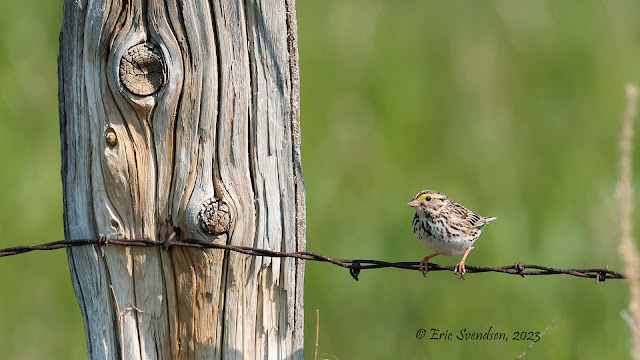Savannah sparrow and compositional techniques
I have never considered myself an artist. If you ever examined any of the work I did in art class, or the stuff that I proudly presented to my mom and dad in those early years, I think you would agree. I might be able to draw the odd dinosaur (a favourite subject of mine when making colouring pages for my kids) and can even produce a passable flower, but don't ask for details or the actual representation of something specific. My specific talent is button-pushing, both literally and figuratively.
I enjoy photography because there is a science to it and it relies a great deal on numbers. I have always been drawn to both cameras and computers, and the advent of the digital camera was a marriage too good to miss out on. I learned a lot about composition and exposure in my early 20's and found those lessons melded nicely with what this new image-capturing medium enabled.
My first passion in life has to do with wildlife and the environment. Photography is a close second, and so I spend most of my time photographing living things. However, I also try to create attractive images when pursuing these. I quite like the photo I took last week of the savannah sparrow in Alberta. It's not just the bird, but the way the entire image works together. Below are some of the reasons:
1. I used a good, long lens (500mm PF Nikkor f/5.6 prime) on a good camera body (D500 - raw exposure) and was close enough to the subject that I could produce a crisp image with little distortions, no noise, and fantastic detail.
2. I focused on the subject and reframed - using the rule of thirds - to capture an image that was both attractive and interesting.
3. The out-of-focus background has a nice bokeh to it; one of the benefits of a good quality lens with a 9-bladed aperture.
4. The image was photographed so that the wire, bird, and fence post was all in focus. This was done by keeping the sensor plane parallel to the wire and fence post. If I photographed this to the left, right, or at a different height (I was crouched at the time), the image may not have been as good.
5. I actually took a fair number of shots; this one had the bird in the best position and showed enough colour and detail so that an identification is possible.
6. The bird itself is framed slightly; the fence post edge on the left and the blurry blade of grass on the right help to draw your eye on the subject.
7. The fence post itself has a lot of interesting details in it. Had it been something with less appeal the photo wouldn't have worked so well.
I rarely look for a place to shoot and wait for something to happen. Rather, I explore an area and shoot when something strikes my fancy. The truth is that I may take 100 photos and end up with maybe a dozen that I actually like. Of those that I like, maybe one stands out.
For me, photography is an excuse to explore the natural world and a hobby to enjoy at home as I identify species and play with the images to improve their final appearance. I hope to be doing this for a very long time.
Thanks for reading.
Eric Svendsen www.ericspix.com




Comments
Post a Comment